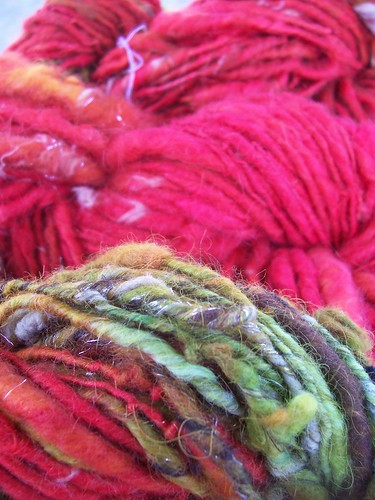
Next in the series of Interviews with Fiber Artists is Rachel-Marie of KnittyDirtyGirl.com. To learn more about Rachel-Marie's jump into the world of full-time fiber artist, read this excellent Etsy article
How'd you get started dyeing?
I started dyeing with kool-aid and yarn from my beloved Brown Sheep Company. I don't remember what sparked my interest in dyeing. Being able to create my own colors has helped me to be a more creative fiber artist.
Which came first: the knitting, the dyeing or the spinning?
Knitting, then dyeing, then spinning. I am still working on my knitting skills, my spinning expertise has far exceeded my knitting talents.
How did the business begin?
I started selling my knits with trial and error. I have learned from some not so smart business choices. I started selling my knits to friends, then at a co-op, next on ebay, and finally on Etsy.
Did you intentionally grow your business this direction?
It just sort of evolved into what it is today. It is completely surprising to me that I have managed to survive off of my artsy income.
What's it like to work from home?
I have struggled working full time out of our apartment, but only because it is so crowded. The high chair, fish tank, bird cage, spinning wheels, tv, baby playpen thing, Dora kids table, stroller, my fiber and laptop, my husband's desk area... it's all crammed into the living room. Once we buy a decent sized house things will be a lot easier. Other than that, the kids are pretty good, and I can't complain.
Can you explain the process of creating your yarn?
I use roving that is already processed for my made to order handspun. I used mill end fiber and farm wool for the bulk of my one of a kind novelty yarns and hand carded batts. The farm wool I wash and card myself. I dye all of my wool, except black, which I can not seem to achieve that color.
Some complain that it can be time consuming, but the actual washing part is mostly a waiting game. I just dump some of the dirty fleece in my washing machine, then I squirt a lot of grease fighting dish soap in. I fill it with hot water, keep the lid open and let soak. I spin it out after a few hours, and repeat. You can repeat that a few times if you like, then make sure to let it soak in hot water with no soap, to rinse. You must not agitate the wool, and do not let the water sit so long that it gets cold.
If the sheep has had an exciting life with no coat the fleece may need to go through a wool picker. Which I do not have. I pick out the bits I see potential in, and after they are dry I card them. I dye the fiber either before or after the carding process depending on the amount of vegetation.
Finally I gather all of my materials (sari silk, bling, cotton, wools) and make some batts using my drum carder. My farm wool usually does have some vegetation left in it. I love it, it shows my customers that I really am using farm wool. I blend it with softer, processed, superwash merino mill ends, which makes the vegetation less noticeable.
Here I am spinning my made to order yarns using already processed roving:
What's the inspiration process like?
Sometimes, but it's normally like I try and keep the dyepot full at all times. I usually become inspired from my dyed stash. I usually pull names related to yarns from books, movies, or tv shows that I like. I choose names from these medias that fit the yarn.
Sometimes I get ideas or concepts for well thought out yarns. Like my gnome series (above) and then execute the idea. But mostly I just look at my shop and see what I think it could use more of based on price points, color, and season. Sounds boring, but it works for me. I come up with better yarn just looking at my stash and trying to make the best of it.
What do you wish you’d planned for before you went full-time?
I know now that June and July are very slow for me, and from now on I am going to try and save some money for those months. Or supplement my income in some way during that time. I actually just got offered a part time, one day a week, job at the new local yarn shop in my city! They are carrying my yarns, this steady income should help us get by when retail is otherwise slow. Plus, it will help me learn more about my industry, connect with my customer base, and get me out of the house once a week!
What has surprised and delighted you about being a fiber artist?
The endless possibilities! Just when you think you are bored another door is opened, like natural dyeing. You could devote your whole life's work on that topic alone.





0 comments:
Post a Comment